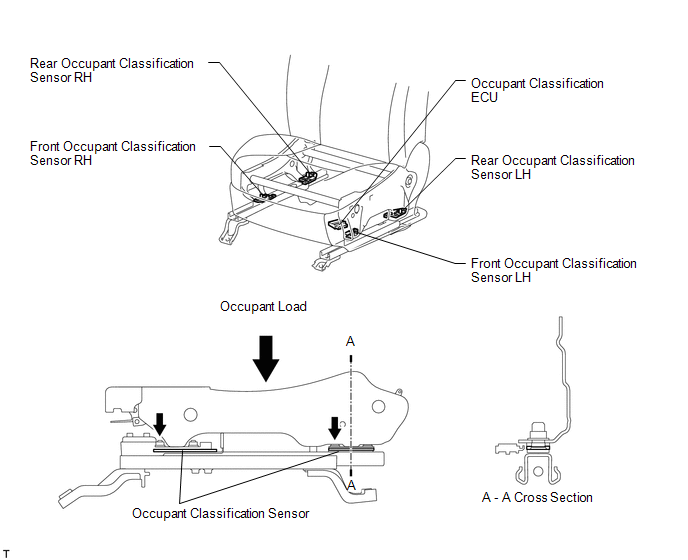Toyota 4Runner: System Description
SYSTEM DESCRIPTION
1. DESCRIPTION OF OCCUPANT CLASSIFICATION SYSTEM
(a) GENERAL DESCRIPTION
(1) In the occupant classification system, the occupant classification ECU calculates the weight of the occupant based on signals from the occupant classification sensors. This system recognizes the occupant to be a child if it detects a weight of less than 36 kg (79.4 lb), and disables the front passenger airbag assembly and side airbag (front passenger side).
(2) This system is mainly comprised of 4 occupant classification sensors that detect the load on the front passenger seat. The occupant classification ECU controls the system, and the passenger airbag ON/OFF indicator indicates the on/off status of the front passenger airbag and side airbag (front passenger side).
(b) OCCUPANT CLASSIFICATION SENSOR

(1) The occupant classification sensors are installed on 4 brackets connecting the seat rail and seat frame. Accordingly, when load is applied to the front passenger seat by an occupant sitting in it, the occupant classification sensors register a distortion.
(c) DESCRIPTION FOR PASSENGER AIRBAG ON/OFF INDICATOR
(1) The passenger airbag ON/OFF indicator is installed on the air conditioning control assembly. This indicator informs the driver whether the occupant classification ECU will enable or disable the front passenger airbag assembly and side airbag (front passenger side).
(2) If a malfunction occurs in the occupant classification system, the passenger airbag ON/OFF indicator ("OFF") and SRS warning light will come on.
 Initialization
Initialization
INITIALIZATION
1. ZERO POINT CALIBRATION
NOTICE:
Make sure that the front passenger seat is not occupied before performing the
operation.
HINT:
Perform the zero point calibration and sensitivit ...
 Problem Symptoms Table
Problem Symptoms Table
PROBLEM SYMPTOMS TABLE
HINT:
Use the table below to help determine the cause of problem symptoms.
If multiple suspected areas are listed, the potential causes of the symptoms
are lis ...
Other materials about Toyota 4Runner:
Unable To Connect To Call Center
DESCRIPTION
This may occur when the intensity of the telephone radio frequency was very weak,
PRL updates are required or the Safety Connect system has a malfunction, and a DTC
is stored.
PROCEDURE
1.
CHECK COMMUNICATION SERVICE C ...
Open in CAN Main Wire
DESCRIPTION
There may be an open circuit in the CAN main wire and/or DLC3 branch wire when
the resistance between terminals 6 (CANH) and 14 (CANL) of the DLC3 is 69 Ω or higher.
Symptom
Trouble Area
The resistance be ...
0.0096
